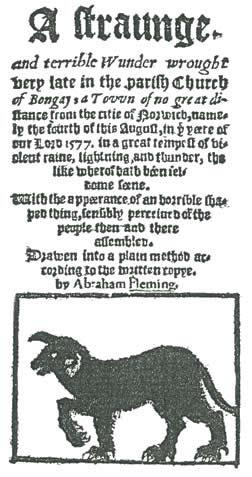Black Shuck in East Anglia
Black Shuck is a ghostly black dog found in the folklore of Norfolk, Suffolk, the Cambridgeshire Fens and Essex.

A straunge, and terrible Wunder wrought very late in the parish church of Bungay: a town of no great distance from the citie of Norwich, namely the fourth of this August, in the yeere of our Lord 1577. in a great tempest of violent raine, lightning, and thunder, the like wherof hath been seldome seene. With the appeerance of an horrible shaped thing, sensibly perceiued of the people then and there assembled. Drawen into a plain method according to the written copye. by Abraham Fleming.
Shuck is derived, according to the Oxford English Dictionary, from the Old English word scucca meaning devil or fiend. A fair description, as the encounter that Fleming described resulted in the deaths of a man and a boy, the collapse of a church steeple and the appearance of scorch marks on the church door.
This desecration and destruction of a church stands in marked contrast to another legendary black dog that is already mentioned in the Rowling canon.
The Church Grim
The Church Grim is a protective presence for a church and churchyard, protecting them against those who would do harm. Including witches warlocks and the devil himself. Despite his benign character the Church Grim’s appearance is very similar to Black Shuck and other Hellhounds of British Folklore, taking the form of a large black dog with red eyes.

Other than their physical description, another common trait is that both Black Shuck and Church Grim are portents of death. The Church Grim will toll the church bell at midnight before a death, and to meet Black Shuck is to be sure you will die before the year is out. It is this reputation that inspired the Grim of wizard legend in Harry Potter.
‘You don’t know what you’re talking about!’ said Ron, starting to get angry. ‘Grims scare the living daylights out of most wizards!’
‘There you are, then,’ said Hermione in a superior tone. ‘They see the Grim and die of fright. The Grim’s not an omen, it’s the cause of death! And Harry’s still with us because he’s not stupid enough to see one and think, right, well, I’d better pop my clogs then!’
Harry Potter and the Prisoner of Azkaban Ch6
The Black Dog and Depression
Samuel Johnson used the term "the black dog" in the 1780s to describe his own depression, and it was subsequently popularized by British Prime Minister Sir Winston Churchill, who also had the disorder.
The black dog I always hope to resist, and in time to drive, though I am deprived of almost all those that used to help me. The neighbourhood is impoverished. I had once Richardson and Lawrence in my reach. Mrs. Allen is dead. My house has lost Levett; a man who took interest in everything, and therefore ready at conversation. Mrs. Williams is so weak that she can be a companion no longer. When I rise my breakfast is solitary; the black dog waits to share it. From breakfast to dinner he continues barking, except that Dr. Brocklesby for a little keeps him at a distance. Dinner with a sick woman you may venture to suppose not much better than solitary. After dinner, what remains but to count the clock, and hope for that sleep which I can scarce expect? Night comes at last, and some hours of restlessness and confusion bring me again to a day of solitude. What shall exclude the black dog from an habitation like this? If I were a little richer, I would perhaps take some cheerful female into the house.
The Life of Samuel Johnson Ch74 - James Boswell
As a metaphor a black dog works well to describe a depression that follows you remorselessly. Its use also helps to externalise the condition, which in turn can help sufferers to create strategies to cope with it.
J. K. Rowling’s own metaphor for depression are the dementors:
I do not think that these are just characters. I think they are a description of depression. "Yes. That is exactly what they are," she says. "It was entirely conscious. And entirely from my own experience. Depression is the most unpleasant thing I have ever experienced."
What does she mean?
"It is that absence of being able to envisage that you will ever be cheerful again. The absence of hope. That very deadened feeling, which is so very different from feeling sad. Sad hurts but it's a healthy feeling. It's a necessary thing to feel. Depression is very different."
Treneman, Ann. J.K. Rowling, the interview, The Times (UK), 30 June 2000
Depression and Therapy
Absent Professor Lupin teaching corporeal Patronus production, in our world help for clinically diagnosed depression comes in the form of therapy. J. K. Rowling has been very open about her own cognitive behaviour therapy in the remarkable Adeel Amini interview. This interview is currently unavailable again, but can be accessed in this archive.
“I would recommend it highly. I would. Yeah, I think it was absolutely invaluable. Well it worked for me so obviously I’m very ‘pro’ it. You have to do a lot of work yourself, you know. Realistically, you have to do a lot of work, you have to be prepared to do what you’re asked to do and persevere. I think I was in counselling for nine months, I probably could have done longer. I think I was very hung-up on the idea of becoming reliant on anything, which was partly a feature of my condition. I was in such an isolated position and bizarrely you become afraid of dependent on anything because then [you think] ‘I’ll lose that’. So I probably came out of it a little bit early but…” She pauses. But it all worked out for the best, I venture? “Absolutely. And it gives you strategies for thereafter.
On Cognitive Behaviour Therapy: The Adeel Amini – JK Rowling Interview
Robin Ellacott like Rowling has received Cognitive Behaviour Therapy or CBT. And like Rowling, she terminated her therapy earlier than she could have, in Robin’s case after only five sessions.
Her therapist had been unhappy that she was terminating treatment.
“We recommend a full course,” she had said.
The therapist’s smile had been chilly.
“The CBT’s been great,” Robin had said. “It’s really helped with the anxiety, I’m going to keep that up…”
Lethal White Ch3
Some of the techniques she has learned has proved useful, but it is yet to be seen if Robin will return for further treatment.
Mid-morning, Robin had taken refuge in the bathroom before Matthew could realize she was hyperventilating again. Sitting on the bathroom floor, she had recourse to the technique she had learned in therapy, cognitive restructuring, which sought to identify the automatic thoughts of pursuit, pain and danger that sprang into her mind given certain triggers. He’s just some idiot who works for the Sun. He wants a story, that’s all. You’re safe. He can’t get at you. You’re completely safe.
Lethal White Ch39
Therapy and The Running Grave
From the online Twitter Q&A last year, we know that therapy will be suggested to Cormoran Strike. We also know that his half-sister Prudence is a Jungian therapist.
His half-sister Prudence, Jungian therapist and fellow illegitimate child of Jonny Rokeby, had been in touch again by email, asking whether he was free for a drink or dinner on three specific dates. He still hadn’t answered her, largely because he hadn’t decided whether he actually wanted to meet her.
It would have been easier had he been dead set against a meeting, but ever since Prudence had contacted him directly, over a year ago, he’d felt an odd pull towards her. Was it shared blood, or the fact that the two of them were bracketed together in being the accidental children, the illegitimates, two unwanted consequences of Rokeby’s almost legendary promiscuity? Or did it have something to do with turning forty? Was he, in some unacknowledged part of himself, wanting to reckon with a past as painful as it was complicated?
The Ink Black Heart Ch15
It may be that Strike needs therapy in The Running Grave, and no wonder. With a failing body and in an emotional crisis, he will be forced to return to Norfolk, the scene of “the worst experience of his young life”.
If the Black Dog does come for Cormoran, lets hope he follows his creators advice.





